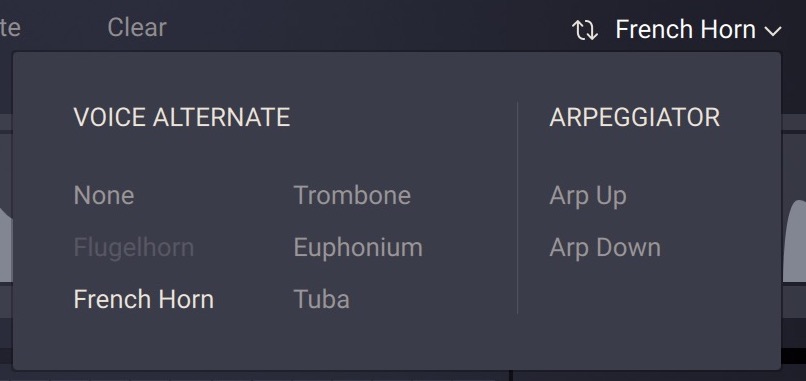Playing VALVES
VALVES' engine distributes the notes you play in a meaningful way across its five instruments.
In VALVES you can activate up to five instruments. VALVES will dynamically allocate the MIDI notes that you input to each of the five instruments based on their pitch. The lowest note will be allocated to the tuba, the second lowest to the euphonium, then the trombone and french horn and finally the highest to the flugelhorn. This Smart Voice Assignment divides and arranges your played notes amongst the five instruments, taking into account their natural ranges.
The number of notes played and the number of instruments activated affect the way that VALVES distributes notes to instruments. When you have fewer than five instruments active or play fewer or more than five notes, VALVES interprets the input in the following way.

The "last note" in this table represents the last note received by the instrument. Imagine you have two instruments active but play a three note chord. In this case, the last two notes received would be distributed across the two available instruments based on their pitch. Then if you play another note, the oldest note will be discarded and replaced by the new note at the start of the next articulation of the instrument that the note is distributed to.
In another example, if you play a C triad chord and the notes are pressed within a 24 ms window, the C will be distributed to the instrument with the lowest register, then the E to the next one up and the G to the instrument with the highest register. The way VALVES interprets note input is defined by the Voice Detection setting on the Settings page. If notes are played gradually, VALVES interprets this as "1 note" or "2 notes" and will reallocate notes as described above. For more information, refer to Settings Page
Tip
When True Range is deactivated and the assigned notes are not part of the natural range of the instrument, they get shifted by an octave until they are in range.
Voice Alternate
VALVES is five-note polyphonic with the five notes being assigned to each of the five instruments. In the Voice Alternate section on the right side of an instrument's track in the Sequencer page you will find a Voice Alternate menu.
 |
The Voice Alternate section
Here you can assign an instrument with which the currently selected instrument will alternate the pitch it plays. This helps you to achieve a more natural musical style akin to a real brass ensemble. Instead of each instrument playing the same notes it can switch alternate notes with another instrument that you choose.
In the following example, imagine you play five notes like C-E-G-B-D with B and D being the top two notes and have the french horn and flugelhorn set to alternate with each other. This would be the result.

An example of voice alternation
If an instrument has its Voice Alternate set to Arp Up or Arp Down, VALVES takes the chord you play and plays an arpeggio either up or down based on the notes in the chord.